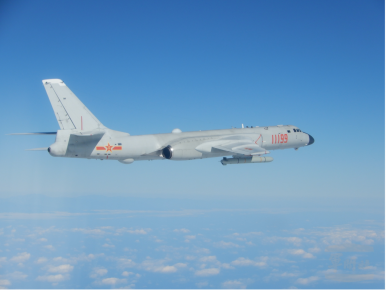By Franz-Stefan Gady
 The Republic of China Air Force (ROCAF) scrambled fighter jets to intercept and escort an undisclosed number of People’s Liberation Air Force (PLAAF) Xian H-6K bombers, Sukhoi Su-30 fighter aircraft, and a Shaanxi Y-9JB (GX-8) electronic warfare and surveillance plane conducting a long-range patrol near Taiwan on December 18, according to Taiwan’s Ministry of Defense.
The Republic of China Air Force (ROCAF) scrambled fighter jets to intercept and escort an undisclosed number of People’s Liberation Air Force (PLAAF) Xian H-6K bombers, Sukhoi Su-30 fighter aircraft, and a Shaanxi Y-9JB (GX-8) electronic warfare and surveillance plane conducting a long-range patrol near Taiwan on December 18, according to Taiwan’s Ministry of Defense.
The PLAAF aircraft took off yesterday morning from undisclosed airfields in China’s Guangdong Province and flew over the Bashi Channel, a strategically pivotal waterway connecting the South China Sea with the western Pacific Ocean, into the Pacific before returning to their home bases. It is unclear whether the aircraft circumvented the island. The aircraft were supported by two People’s Liberation Army Navy warships, which were spotted by Republic of China Navy vessels and ROCAF aircraft just outside Taiwan’s southeastern air identification zone.
The December 18 event constitutes the first time since May 25 that Taiwan had to scramble fighter jets to intercept Chinese military aircraft in the vicinity of Taiwan. On that day, ROCAF fighter jets intercepted two H-6K bombers near Taiwan flying over the Miyako Strait. The ROCAF also conducted a scramble on May 11 when Xian H-6K bombers and support aircraft flew over the Bashi Channel and went on to circle Taiwan with two groups of H-6K bombers from the People’s Liberation Army’s (PLA) Eastern Theater Command and Southern Theater Command with one formation flying clockwise and the other counter-clockwise.
May 11 also was the first time that the PLAAF used Sukhoi Su-35S (NATO reporting name: Flanker-E) fighter jets as an escort for a H-6K bombers operating near Taiwan. The ROCAF usually relies on its force of Lockheed Martin F-16 A/B Fighting Falcons to conduct scrambles. In October, the service took delivery of its first upgraded F-16 Fighting Falcon Viper (V) Block 70 fighter jet.
This month’s long-range PLAAF patrol was the first since May 2018. So far, the PLAAF has circumvented Taiwan six times with its bomber force in 2018. As Derek J. Grossman noted in a social media post earlier this week, the six-month suspension of flight operations and air combat drills near the island was likely to due to waiting out the election results of the recent midterm election results and the hopes for a China-U.S. military-to-military reset.
China has over the past years upped the operational tempo of long long-range patrols and air exercises around and over the Miyako Strait — a principal entryway for the People’s Liberation Army Navy (PLAN) into the Pacific Ocean—and the Bashi Channel near Taiwan.
“In the event of a conflict with Taiwan or Japan, the Miyako Strait and Bashi Channel would be critical chokepoints, the seizure of which could delay third party intervention (e.g., by the United States) and secure the so-called first island chain,” I wrote in May.
Furthermore, I pointed out that People’s Liberation Army doctrine specifically calls for the sealing off of the Yellow Sea, South China Sea, and East China Sea from U.S. air and naval assets in the event of a military confrontation, which would mandate a quick seizure of the waterways by the Chinese military to keep enemy forces at bay.
No comments:
Post a Comment